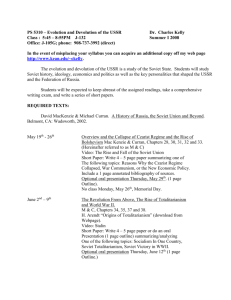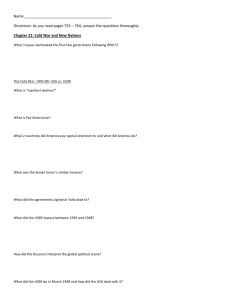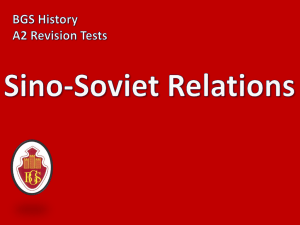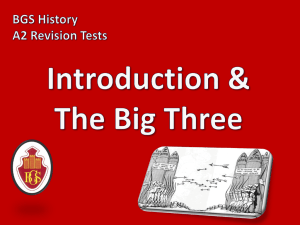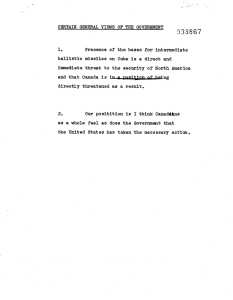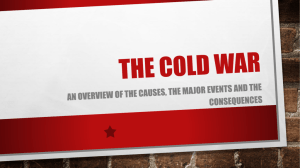9697 HISTORY MARK SCHEME for the October/November 2012 series
advertisement
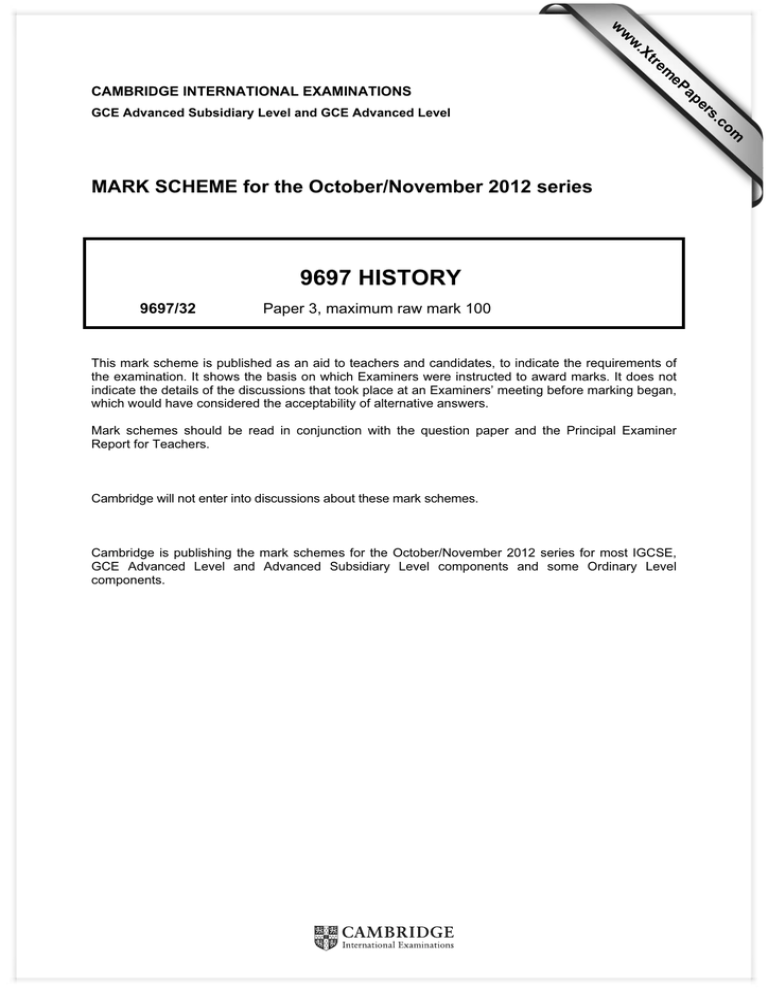
w w ap eP m e tr .X w CAMBRIDGE INTERNATIONAL EXAMINATIONS 9697 HISTORY 9697/32 Paper 3, maximum raw mark 100 This mark scheme is published as an aid to teachers and candidates, to indicate the requirements of the examination. It shows the basis on which Examiners were instructed to award marks. It does not indicate the details of the discussions that took place at an Examiners’ meeting before marking began, which would have considered the acceptability of alternative answers. Mark schemes should be read in conjunction with the question paper and the Principal Examiner Report for Teachers. Cambridge will not enter into discussions about these mark schemes. Cambridge is publishing the mark schemes for the October/November 2012 series for most IGCSE, GCE Advanced Level and Advanced Subsidiary Level components and some Ordinary Level components. om .c MARK SCHEME for the October/November 2012 series s er GCE Advanced Subsidiary Level and GCE Advanced Level Page 2 Mark Scheme GCE AS/A LEVEL – October/November 2012 Syllabus 9697 Paper 32 GENERIC MARK BANDS FOR ESSAY QUESTIONS Examiners will assess which Level of Response best reflects most of the answer. An answer will not be required to demonstrate all of the descriptions in a particular level to qualify for a Mark Band. Band Marks Levels of Response 1 21–25 The approach will be consistently analytical or explanatory rather than descriptive or narrative. Essays will be fully relevant. The argument will be structured coherently and supported by very appropriate factual material and ideas. The writing will be accurate. At the lower end of the band, there may be some weaker sections but the overall quality will show that the candidate is in control of the argument. The best answers must be awarded 25 marks. 2 18–20 Essays will be focused clearly on the demands of the question but there will be some unevenness. The approach will be mostly analytical or explanatory rather than descriptive or narrative. The answer will be mostly relevant. Most of the argument will be structured coherently and supported by largely accurate factual material. The impression will be that a good solid answer has been provided. 3 16–17 Essays will reflect a clear understanding of the question and a fair attempt to provide an argument and factual knowledge to answer it. The approach will contain analysis or explanation but there may be some heavily descriptive or narrative passages. The answer will be largely relevant. Essays will achieve a genuine argument but may lack balance and depth in factual knowledge. Most of the answer will be structured satisfactorily but some parts may lack full coherence. 4 14–15 Essays will indicate attempts to argue relevantly although often implicitly. The approach will depend more on some heavily descriptive or narrative passages than on analysis or explanation, which may be limited to introductions and conclusions. Factual material, sometimes very full, will be used to impart information or describe events rather than to address directly the requirements of the question. The structure of the argument could be organised more effectively. 5 11–13 Essays will offer some appropriate elements but there will be little attempt generally to link factual material to the requirements of the question. The approach will lack analysis and the quality of the description or narrative, although sufficiently accurate and relevant to the topic if not the particular question, will not be linked effectively to the argument. The structure will show weaknesses and the treatment of topics within the answer will be unbalanced. 6 8–10 Essays will not be properly focused on the requirements of the question. There may be many unsupported assertions and commentaries that lack sufficient factual support. The argument may be of limited relevance to the topic and there may be confusion about the implications of the question. 7 0–7 Essays will be characterised by significant irrelevance or arguments that do not begin to make significant points. The answers may be largely fragmentary and incoherent. © Cambridge International Examinations 2012 Page 3 Mark Scheme GCE AS/A LEVEL – October/November 2012 Syllabus 9697 Paper 32 Section A 1 ‘A genuine attempt to improve the structure and effectiveness of the United Nations.’ How far do Sources A-E support this interpretation of Soviet demands for reform of the UN Secretariat in 1960-61? L1 WRITES ABOUT THE HYPOTHESIS, NO VALID USE OF SOURCES [1-5] These answers will write about the Soviet proposals for reform of the UN and might use the sources. However, candidates will not use the sources as information/evidence to test the given hypothesis. If sources are used, it will be to support an essay-style answer to the question. L2 USES INFORMATION TAKEN FROM THE SOURCES TO CHALLENGE OR SUPPORT THE HYPOTHESIS [6-8] These answers use the sources as information rather than as evidence, i.e. sources are used at face value only with no evaluation/interpretation in context. L3 USES INFORMATION TAKEN FROM SOURCES TO CHALLENGE AND SUPPORT THE HYPOTHESIS [9-13] These answers know that testing the hypothesis involves both attempting to confirm and to disprove it. However, sources are still used only at face value. L4 BY INTERPRETING/EVALUATING SOURCES IN CONTEXT, FINDS EVIDENCE TO CHALLENGE OR SUPPORT THE HYPOTHESIS [14-16] These answers are capable of using sources as evidence, i.e. demonstrating their utility in testing the hypothesis, by interpreting them in their historical context, i.e. not simply accepting them at their face value. L5 BY INTERPRETING/EVALUATING SOURCES IN CONTEXT, FINDS EVIDENCE TO CHALLENGE AND SUPPORT THE HYPOTHESIS [17-21] These answers know that testing the hypothesis involves attempting both to confirm and disconfirm the hypothesis, and are capable of using sources as evidence to do this (i.e. both confirmation and disconfirmation are done at this level). L6 AS L5, PLUS EITHER (a) EXPLAINS WHY EVIDENCE TO CHALLENGE/SUPPORT IS BETTER/PREFERRED, OR (b) RECONCILES/EXPLAINS PROBLEMS IN THE EVIDENCE TO SHOW THAT NEITHER CHALLENGE NOR SUPPORT IS TO BE PREFERRED [22-25] For (a) the argument must be that the evidence for agreeing/disagreeing is better/preferred. This must involve a comparative judgement, i.e. not just why some evidence is better, but also why other evidence is worse. For (b) include all L5 answers which use the evidence to modify the hypothesis (rather than simply seeking to support/contradict) in order to improve it. © Cambridge International Examinations 2012 Page 4 Mark Scheme GCE AS/A LEVEL – October/November 2012 Syllabus 9697 Paper 32 CONTEXT: Since 1945, the Soviet Union felt an increasing sense of isolation within the UN. The USSR had become convinced that the UN and Security Council were pro-Western and anti-communist. This is reflected in the Soviet Union’s use of the veto and its claims that the UN was a ‘tool of the USA’ during its involvement in the Korean War. The USSR had effectively forced the premature resignation of the Norwegian Secretary-General Trygve Lie in 1953. By 1960, the USSR was branding Lie’s successor, Sweden’s Dag Hammarskjold, as pro-Western, largely because the USSR disagreed with the UN’s actions in the Congo. More countries had joined the UN, many of them recently independent as a result of decolonisation. Their addition made the General Assembly, already subservient to the Security Council, more unwieldy and ineffective. With the Security Council largely impotent because of the Cold War and the General Assembly ineffective, Hammarskjold extended the powers of the Secretary-General beyond those originally envisaged in the Charter. SOURCE A: Context: From an article by a Russian political commentator in 1989, a time when the Cold War was drawing to a close and perspectives were beginning to change. Content (Face Value): The writer claims that Khrushchev’s demands for a Troika were based on an insistence ‘on the principle of equal representation and participation in the UN.’ Since the Western Powers were ‘running things at the time’, this was unfair on the socialist/communist and neutral states. Soviet demands for reform were therefore designed to make the UN fairer and more representative. (Y) Content (Beyond Face): The source claims that the Western Powers (mainly the USA) effectively controlled the UN in 1960/61 (X-Ref with Source C: Nehru). This implies that the views of communist member states (primarily the USSR) and of the neutral states (including the many newly independent member states) were not afforded fair representation. Since nations fitted into one of three categories (the Western Bloc, the Socialist Bloc and the non-aligned states), there is some logic in suggesting that this should be reflected in the structure of the UN (X-Ref with Source B). (Y – Soviet proposals were designed to make the UN more representative of all member states). However, Khrushchev failed to convince the neutral states that his demands were justified (X-Ref with Sources D and E, which show that Hammarskjold survived calls for his resignation and replacement with a Troika in the autumn of 1960); Hammarskjold retained the trust and respect of the majority of these nations, while many were sceptical of Soviet motives (X-Ref with Source C: Hussein). Although Hammarskjold’s death led to renewed calls for the Troika (X-Ref with Source D), he was replaced by a single Secretary-General (U Thant). Source A also suggests that Khrushchev had other motives beyond creating fairness and representation - ‘a broader strategic position’ implies that Khrushchev was seeking to enhance the position of the USSR within the UN. The USSR had felt isolated within the UN since 1945, as shown by its frequent use of the veto and its frustration over the UN’s refusal to admit the PRC. Arguably, Khrushchev was trying to curry favour with the new member states in order to secure their support. King Hussein (X-Ref with Source C) interpreted this as an attempt to spread communism. The Troika would have enabled the USSR to prevent the UN acting through the General Assembly on the advice of the Secretary-General, since it would effectively have the right of veto (X-Ref with Sources C and D). While this is a Russian source and believes that the UN was dominated by the West, it implies that Khrushchev had ulterior motives. The use of the word ‘demanded’ makes it clear that the writer is being, at least in part, critical of Khrushchev. (N – while the UN was in need of reform to provide greater fairness and representation, Soviet motives were not genuinely aimed at improving the effectiveness of the UN). © Cambridge International Examinations 2012 Page 5 Mark Scheme GCE AS/A LEVEL – October/November 2012 Syllabus 9697 Paper 32 SOURCE B: Context: Soviet Premier Khrushchev addressing the UN General Assembly in September 1960. Content (Face Value): Khrushchev puts forward an argument in favour of reform of the UN structure, particularly the Secretariat. He believes such reforms are essential. He advocates the replacement of the SecretaryGeneral with a committee of three people, representative of the three distinct groups within the UN the Western Powers, the Socialist Powers and the non-aligned (neutralist) states. He claims this would give fairer representation to all nations and lead to a ‘more correct implementation of the decisions taken’ by the UN General Assembly and the Security Council. He advocates reform on the grounds that it would help to make the world safer and more peaceful. (Y, the USSR wanted to make the UN fair and more representative). Content (Beyond Face Value): Khrushchev argues in favour of urgent reform of the Secretariat, with a view to improving the functioning of the UN. His language is calm and measured (not always his style), and his argument that the Secretariat should provide representation for all UN members seems reasonable (X-Ref with Sources C and D, which both agree that there was a need to review UN structures in the light of increased membership) (Y). However, in advocating reform he does not state why he believes they are necessary. Instead, he makes thinly disguised attacks both on the Western Powers and the Secretary-General. He claims that the Western Powers are apprehensive about the large number of new states which have joined the UN, the implication being that they posed a potential threat to Western dominance of the UN. Such a carefully worded statement was designed to ingratiate the USSR with these new states (Khrushchev’s claims that they were the victims of Western colonialism did much to ingratiate the Soviet Union with leaders such as Nkrumah in Ghana). Similarly, by stating that the reforms would allow ‘a more correct implementation of the decisions taken’, Khrushchev implies that Hammarskjold was not correctly implementing the decisions of the General Assembly and the Security Council. Khrushchev repeats the USSR’s long-held belief that the UN was dominated by the Western powers, especially the USA, a view which is endorsed by some of the other sources (XRef with Source C and Source A). As the only major communist member, the Soviet Union felt isolated, its power restricted to preventing UN action (through the veto) rather than initiating it. The UN’s refusal to allow entry to the PRC added to this sense of frustration. Khrushchev believed that Hammarskjold was pro-Western and openly accused the Secretary-General of this at a subsequent meeting of the General Assembly, demanding his resignation. Hammarskjold had developed the role of Secretary-General beyond that originally envisaged in the Charter, and was taking decisions which should have been taken in the Security Council (X-Ref with Source D). It could be argued that Khrushchev was trying to restrict this newly-adopted power by suggesting a Troika, which would have made the Secretariat as impotent as the Security Council (X-Ref with Sources C, D and E). (N – Khrushchev was trying to secure Soviet interests by making the UN less effective by controlling the power of the Secretary-General). SOURCE C Context: Statements to the UN General Assembly by the leaders of two of what Khrushchev referred to as the ‘neutralist’ states in response to the USSR’s demands for reform of the UN Secretariat, 1960. Content (Face Value): King Hussein sees Khrushchev’s demands as a further attempt to weaken the UN by destroying the authority of the Secretary-General (N). Nehru agrees with Khrushchev that there is a need for reform of the UN, which is too heavily weighted towards the Western powers, a problem which became more pronounced as new nations joined the UN (Y). However, Nehru believes that any such reform should © Cambridge International Examinations 2012 Page 6 Mark Scheme GCE AS/A LEVEL – October/November 2012 Syllabus 9697 Paper 32 not be rushed and should be based on full consultation and careful deliberation (N – while reforms were needed, the USSR was attempting to rush them through, which would have been to the UN’s detriment). Content (Beyond Face Value) The source shows the responses of the leaders of two ‘neutralist’ states to Khrushchev’s demands for reform of the UN Secretariat. King Hussein argues against the Soviet demands, claiming that they are a continuation of the USSR’s on-going attempt to destroy the UN by weakening its major organs. He claims that this is just one more tactic (rather more subtle than some of the others) to enable the USSR to achieve its aims (X-Ref with Source D). However, it should be noted that King Hussein uses emotive, anti-communist language, with the implication that the USSR was attempting to spread its influence amongst ‘neutralist’ nations, such as the Arab states (N, but the reliability of the source is hindered by the language used). Prime Minister Nehru’s comments are made in a more measured way. He accepts that there are fundamental problems with the structure of the UN, and especially that it is weighted in favour of the Western powers (X-Ref with Source A), an issue which has become more pronounced with increasing membership (Y). However, he disagrees with the Soviet insistence on changes in ‘the immediate future’ (X-Ref with Source B); he feels that any reform of the UN needs to be carefully thought out and based on consultation with member states (X-Ref with Source D). This might imply that Nehru had concerns over Soviet motives for demanding immediate reform (N while reforms were needed, the USSR was attempting to rush them, which would have been to the UN’s detriment). SOURCE D Context: President Kennedy addresses the UN General Assembly, September 1961. The USSR’s demands in the autumn of 1960 for Hammarskjold’s resignation and replacement by a Troika had failed (Hammarskjold refused to resign and received widespread support). However, Hammarskjold’s death in a plane crash while trying to arrange peace in the Congo plunged the UN back into the same constitutional crisis. Content (Face Value) While accepting that there is a need to review the organisation of the UN in the light of the ‘enormous change in membership’, and pledging the USA to take a full part in such a review, Kennedy rejects the Soviet proposal on the grounds that it would diminish the authority of the General Assembly. (Balanced – Y: the USA accepts the need to review the structure of the UN; N: Soviet proposals would weaken rather than strengthen the UN). Content (Beyond Face Value): Hammarskjold’s death would have created a problem for the UN - either it would be forced to find a replacement as Secretary-General or change the structure of the Secretariat in line with Soviet proposals for a Troika. Finding a replacement that everyone could agree on would not be easy and the USSR renewed its demands for a Troika. Kennedy made this speech to a General Assembly which would have been shocked and bewildered by the news of Hammarskjold’s death. It is very much the speech of a politician. The language is calm and measured; Kennedy portrays the USA as being firmly behind the notion of the UN as a place where all members are ‘equal and sovereign’ - this implicitly rejects claims that the UN is biased towards the West and the USA (X-Ref with Sources C [Nehru] and A). While willing to take part in any review of the UN’s structure, especially in view of the rapid growth in membership (X-Ref with Sources B. C and E), Kennedy portrays the USA as being determined to maintain the prestige and authority of the UN, and especially the General Assembly. Kennedy avoids criticising the USSR; however, by showing how the adoption of the Troika would undermine the prestige and effectiveness of the UN, he implies that this was the USSR’s real motive (X-Ref with Source C: Hussein). The statement that the Troika would ‘entrench the Cold War in the headquarters of peace’ underlines this point. Kennedy makes the USA sound like the voice of © Cambridge International Examinations 2012 Page 7 Mark Scheme GCE AS/A LEVEL – October/November 2012 Syllabus 9697 Paper 32 fairness and reason, the same stance which Khrushchev adopted when he first made his Troika proposals (X-Ref with Source B). (Y, while accepting there is a need to review the structure of the UN in view of increased membership, the source rejects Soviet proposals as threatening the prestige and authority of the UN – N by inference). SOURCE E Context: An academic article written in 1972, eleven years after Hammarskjold’s death and after U Thant had completed his double-term of office as UN Secretary-General. After seven weeks of haggling the UN finally selected U Thant who seemed to be an inconspicuous man from a neutral country and therefore acceptable to all. Contemporaries and historians alike have often rated him as a failure and subjected him to unfair comparisons with Hammarskjold. Content (Face Value): The source gives a factual account of the role of the Secretary-General and how it developed under Hammarskjold. Originally intended as an administrative officer, Hammarskjold took on greater powers because the Security Council was made impotent by the Cold War and the General Assembly had become unwieldy due to the increase in membership. Khrushchev did not like the fact that the Secretary-General’s position had grown in power. While the source mentions the Soviet attempts to remove Hammarskjold and replace him with a Troika, it makes no judgement about these proposals (NEUTRAL – shows that the UN was not functioning as originally intended, but draws no conclusions about Soviet motives or the likely outcome of Khrushchev’s proposals). Content (Beyond Face Value) The source shows how the UN did not function as originally intended. The Cold War split the Security Council, and the right of veto meant that it could not reach agreement on major issues. The USSR used the veto frequently in the early years of the UN. The General Assembly, never intended as the power house of the UN, became more unwieldy due to increased membership. Hammarskjold had to enhance the role of Secretary-General to enable the UN to function at all. In order to do this, he had to bypass the Security Council and rely on support in the General Assembly, most of which came from the smaller, neutral states. In doing so, Hammarskjold upset all of the Great Powers at some stage, and was subjected to criticism from most of them. Khrushchev accused Hammarskjold of proWestern bias (in particular as a result of UN actions in the Congo) and demanded his resignation. The source shows that the USSR was right to draw attention to the need for a review of UN structures, which were not operating as intended (X-Ref with Sources A, B, C and D). However, it passes no judgement on Soviet proposals; it merely states that the USSR wished to replace Hammarskjold with a Troika (NEUTRAL – shows that the UN was not functioning as originally intended, but draws no conclusions about Soviet motives or the likely outcome of Khrushchev’s proposals). However, the last line contains an implicit criticism of the Soviet proposal – if each of the members of the Troika had the right of veto, the Troika would become as ineffective and impotent as the Security Council as a result of Cold War rivalries (X-Ref with Source D) (N – Soviet proposals would have had the predictable outcome of making the UN less effective, implying their motive was not to make the UN fairer, more representative and more effective. Rather, they were designed to close the loophole by which Hammarskjold had kept the UN functioning). The source was written in 1972, so the writer knew that the Soviet proposals were rejected and that Hammarskjold was replaced by U Thant, who faced major problems as SecretaryGeneral. The American element in the provenance might lead some to assume that it contains bias – in fact, the language is neither opinionated nor judgemental, while the content is factual and can be verified by contextual knowledge. © Cambridge International Examinations 2012 Page 8 Mark Scheme GCE AS/A LEVEL – October/November 2012 Syllabus 9697 Paper 32 CONCLUSION Most of the sources agree that there were fundamental flaws in the structure of the UN in 1960-61. These were due to two factors. Firstly, the Cold War meant that the Security Council rarely reached agreement, and the right of veto meant that it had become effectively impotent. Secondly, increased membership was not reflected in the structure of the UN, which left the Western Powers with disproportionate influence. In order for the UN to function, Hammarskjold enhanced the role of the Secretary-General beyond that laid down in the Charter. In doing so, he incurred the wrath of the Great Powers (which he saw as proof of his neutrality), but especially the USSR, which judged him as pro-Western and anti-Communist. Hammarskjold’s power base lay within the General Assembly, ironically with the neutral states whose rights Khrushchev was claiming to support. Hammarskjold had effectively bypassed the Security Council and prevented the USSR making use of its right of veto. Khrushchev claims that the replacement of the post of Secretary-General with a Troika would address these issues and lead to fairer representation within the UN. Were these claims genuine? • Source A – implies that Khrushchev had other motives beyond the stated intention of improving fairness within the UN. • Source C – King Hussein believes that Khrushchev had other motives, which involved spreading communism. Prime Minister Nehru believes that the Soviet plans should not be accepted straight away, but there should be time for consultation and deliberation. • Source D – Although he does not criticise Khrushchev or accuse him of making demands for the sole benefit of the USSR, Kennedy feels that the proposals are intended to weaken the UN. • Source E – makes no judgement on Khrushchev’s proposals, although there is an implication that the extension of the veto to the Secretariat would make it as impotent as the Security Council. On balance, the hypothesis is not supported. © Cambridge International Examinations 2012 Page 9 Mark Scheme GCE AS/A LEVEL – October/November 2012 Syllabus 9697 Paper 32 Section B 2 ‘The USA did little to prevent the breakdown in relations with the USSR from 1945 to 1949.’ How far do you agree? Candidates may refer to the historical debate regarding the causes of the Cold War, the hypothesis representing the ‘revisionist’ viewpoint. Arguments in support of the hypothesis might refer to the ‘revisionist’ view that it was Truman’s inexperience and strongly anti-communist views which caused the Cold War. While Stalin’s actions can largely be explained by the USSR’s need for security and reluctance to permit the re-growth of Germany, Truman’s actions are less easy to explain. Truman’s use of the atomic bomb in Japan, without prior consultation with the USSR, the ending of Lend-Lease, the Truman Doctrine and the Marshall Plan could all be seen to have motives extending beyond the containment of communism – e.g. ‘dollar imperialism’. In challenging the hypothesis, candidates might refer to Stalin’s open statements regarding worldwide communist revolution, his breaking of the Potsdam promises, his actions in Eastern Europe, the Berlin Blockade etc. The USA saw these events as clear evidence of Soviet expansionism, which needed to be checked by initiatives such as the Truman Doctrine and the Marshall Plan. The ‘post-revisionist’ view that the Cold War was caused by misunderstandings between the super powers (e.g. the USA failing to understand the USSR’s need for security from Western Europe; the USSR’s failure to understand the USA’s motives in wanting to secure a strong Germany) may also be mentioned. 3 ‘From 1950 to 1980, the Cold War consisted of a series of separate regional conflicts in which the superpowers became reluctantly involved.’ How far do you agree? In support of the hypothesis, it could be argued that the globalisation of the Cold War was characterised by a series of regional conflicts which the superpowers became involved in for strategic, diplomatic, security or prestige reasons. In Korea, Kim Il Sung ensured that he had the approval of the USSR and PRC before invading South Korea. Similarly, in Cuba, Castro turned to the USSR for economic and military support to protect his revolution from the USA, just as Batista had relied on American support to maintain his dictatorship. South Vietnamese leaders relied on US support to maintain their dictatorships, while Ho Chi Minh knew that the PRC and the USSR would never tolerate a defeat for North Vietnam. Similarly, in the Middle East, Nasser (Egypt) was emboldened to go to war against Israel in 1967 by Soviet encouragement, while Israel enjoyed the support of the USA. In Africa, regional problems were often exacerbated by the involvement of the superpowers; e.g. in the Congo, where both factions were keen to exploit superpower support. In challenging the hypothesis, it could be argued that the globalisation of the Cold War was characterised by the over-arching policies of the superpowers, who had their own reasons for becoming involved in conflicts and needed little encouragement to do so. The USSR had an interest in encouraging world-wide communist revolution, especially if this could be achieved without direct Soviet involvement (as in Korea). The USSR did not support Castro merely to offer help to a vulnerable communist state, but also for strategic and prestige reasons. The USA was determined to defend and extend its economic power, and this meant protecting vital areas such as Japan, forcing the USA to become involved in Southeast Asia. The Middle East, with its vast oil supplies, was economically and strategically vital for the USSR and USA, while the security of the PRC was threatened by US action in Korea and Vietnam. Decolonisation in Africa offered potential for superpower exploitation of expensive resources, while the power of both the USA and the USSR within the UN depended on securing the support of the newly independent members. The nuclear arms race is an example of the fact that the Cold War existed independently of these regional conflicts. © Cambridge International Examinations 2012 Page 10 4 Mark Scheme GCE AS/A LEVEL – October/November 2012 Syllabus 9697 Paper 32 ‘Confused and inconsistent.’ How fair is this assessment of American policy towards Korea from 1950 to 1953? In support of the hypothesis, it could be argued that Korea had not been in the USA’s original defence perimeter (a factor which led Stalin to give North Korea ‘permission’ to attack the South, believing that conquest could be achieved without American intervention). The arrival of UN troops (primarily American and under the leadership of US General Douglas MacArthur) meant that by September 1950 North Korean troops had been repelled from South Korea – the original aims of the intervention had been met. US troops then carried out a ‘thrust North’ - this marked Truman’s decision to switch from containment to roll-back, although US troops had pre-empted the political decision. This brought Chinese troops into the war and led to disagreements between MacArthur and Truman over whether to use nuclear weapons. MacArthur was replaced by Ridgway and stalemate ensued, leading to the settlement which left Korea split along the 38th parallel. In challenging the hypothesis, it could be argued that American involvement in Korea was part of a consistent attempt to prevent the spread of communism, especially in areas sensitive to US interests (such as Southeast Asia, where the USA’s economic interests were at stake). Gaining UN support for the US mission in Korea was highly advantageous, while the change from containment to roll back emerged logically from the military situation in Korea – the success of UN forces in pushing back the invading North Korean troops had presented the USA with an opportunity to weaken communism in Asia, the USA’s over-arching aim. 5 To what extent was the Sino-Soviet split the result of ideological differences? In order to demonstrate the significance of ideological factors, it could be argued that the Chinese Communist Party had adapted communism to fit the needs of a rural-based economy and so there were inevitable ideological differences between the PRC and the USSR. Initially, Mao was willing to accept the USSR as the leader of world communism, and relations between the two countries were good, culminating in a Treaty of Mutual Assistance and Friendship in 1950. However, the problem arose following Stalin’s death and Khrushchev’s adoption of policies which China believed were revisionist – e.g. • Khrushchev’s public criticism of Stalin (and Lenin) • Khrushchev’s claim that communism could be achieved by methods other than violent revolution • Khrushchev’s belief in ‘peaceful coexistence’ • what the Chinese considered to be Khrushchev’s ‘soft line’ with the USA (e.g. Cuba) • China accused Khrushchev of ‘revisionism’ - revising the teachings of Marx and Lenin to suit his own needs • in retaliation, Khrushchev reduced economic aid to China In order to achieve balance, it could be argued that ideological differences were not the only reason for the split. Competition to become the perceived leader of the ‘communist world’ was undoubtedly a factor, while others could include • frontier dispute – in the 19th century, Russia had taken Chinese territory in Sinkiang Province and China wanted it back • by the late 1970s, PRC and USSR were competing for US support • by the late 1970s, Vietnam supported the USSR while Kampuchea (formerly Cambodia) supported China, in Feb 1979, China attacked Vietnam in retaliation for Vietnam’s attack on Kampuchea (Dec 1978) • in 1984, China set out its grievances against the USSR; these included the presence of Soviet troops in Afghanistan, Soviet backing of Vietnamese troops in Kampuchea and the build-up of Soviet troops along the Chinese borders of Mongolia and Manchuria • relations between China and the USSR did not improve until Gorbachev came to power, culminating in a formal reconciliation in May 1989 when Gorbachev visited Beijing © Cambridge International Examinations 2012 Page 11 6 Mark Scheme GCE AS/A LEVEL – October/November 2012 Syllabus 9697 Paper 32 Analyse the significance of the SALT Treaties. In support of the view that the SALT Treaties achieved little, it could be argued that the difficulties involved in reaching agreement on nuclear arms limitation is reflected in the length of time it took to negotiate the treaties. Discussions began in 1968, yet SALT I was not agreed until 1972, while SALT II was not signed until 1979, by which time relations between the superpowers had deteriorated and it was never ratified by the US Senate. There were disagreements over how arms should be limited and what types of weapons to include (Soviet and US weapons were not easily comparable and there were doubts about the reliability of information on how many weapons each had). There was a tendency to focus on limiting existing weapons, yet this took no account of the new technologies which both superpowers were developing. For example, the Interim Treaty on Offensive Weapons, part of SALT I but only due to last until 1977, limited ICBMs and SLBMs, but ignored MIRV. Similarly, SALT II set limits on missile launchers and strategic bombers, but ignored Cruise Missiles. In order to achieve balance by showing that the SALT Treaties had some success, it could be argued that the SALT Treaties mark the high point of detente, and established a principle of discussion which subsequently led to more effective treaties, such as START. The ABM Treaty (part of SALT I) limited the number of ABM systems for each superpower to two; this meant the USA and USSR retained retaliation capability, which would deter nuclear attack. The Basic Principles Agreement (part of SALT I) led to greater understanding and calmer relations between the USA and the USSR (e.g. trade agreements and joint visits). 7 To what extent did the USA’s role in the world economy change between 1945 and 1991? It could be argued that, as the strongest economy to emerge from the Second World War, the USA was bound to play the dominant role in the global economy. The USA assisted the recovery of the economy of Western Europe, gave preferential treatment to Japan and took the lead in GATT, the World Bank, the Bretton Woods system etc. Even allowing for the problems which the USA faced after the 1970s, by 1991 it was still in a dominant position, though not as dominant as in the period 1945-70. For example, the dramatic fall in US share prices in 1987 led to similar falls world-wide, followed by world-wide trade recession in 1980s. In order to achieve balance, it could be argued that, while the USA dominated the global economy between 1945 and 1970, thereafter its dominance was threatened by factors such as • high costs of defence and the Vietnam War • budget deficit from the late 1960s • falling value of the dollar and the collapse of Bretton Woods system • effects of oil crises • recovery of West Germany and Japan; (USA was reduced to borrowing from Japan) • development of the EEC • rise of the Asian Tigers © Cambridge International Examinations 2012 Page 12 8 Mark Scheme GCE AS/A LEVEL – October/November 2012 Syllabus 9697 Paper 32 ‘External rather than internal factors better explain the emergence of the Asian Tiger economies.’ How far do you agree? All relatively poor and undeveloped at the beginning of the 1960s, the Asian Tigers (Hong Kong, Taiwan, Singapore and South Korea) experienced rapid economic growth between the 1960s and 1990s. They developed an urbanised work force, radically reduced death and birth rates, and achieved high rates of literacy. In 1963, they accounted for 1.6% of the world’s exports; by 1988 they accounted for 8.1% (almost as much as Japan – 9.6%). In supporting the hypothesis, it could be argued that external factors were crucial: • benefited economically from colonial rule or influence – British commerce in Hong Kong and Singapore; Japanese industrialisation and American land reform in South Korea and Taiwan • favourable trading agreements provided by USA and Japan • foreign investment – e.g. South Korea benefited from US aid (and open markets); the USA saw South Korea as a key to preventing the spread of communism in SE Asia (South Korea provided troops for the war in Vietnam); threatened with invasion from China, Taiwan relied on US security guarantees and economic aid; South Korea and Taiwan benefited from ‘soft’ loans and joint industrial ventures with Japan, which benefited from cheap labour. In challenging of the hypothesis, it could be argued the Asian Tigers benefited from similar internal factors: • non-democratic and relatively authoritarian political systems, providing a degree of state control over economic growth – e.g. in South Korea, military rule pushed through forced industrialisation where the government controlled banks, the Economic Planning Board and encouraged conglomerates (e.g. Hyundai, Samsung); in Taiwan, there was a large state sector, tightly controlled and efficiently run; Singapore and Hong Kong practiced state socialism, funding key infrastructure projects and controlling housing and development • export-led growth – e.g. South Korea exported cars (mainly to USA) but car imports were banned; both South Korea and Taiwan imported materials and components from Japan and then exported the finished products, primarily to USA; Singapore and Hong Kong, small states with no food or raw materials of their own, relied on free trade. • favourable demography – availability of cheap labour – e.g. from agricultural sector in South Korea and Taiwan; exiles from China in Hong Kong. • improved educational systems to provide a well-educated, skilled work force • tax and savings incentives, coupled with high growth and income rates • flexibility – e.g. Taiwan moved from the cheap labour-intensive manufacture (e.g. textiles and toys) into heavy industry and infrastructure; Hong Kong moved from textiles into high-tech industries; Singapore became the centre of the new Asian Dollar Market after 1968. © Cambridge International Examinations 2012
